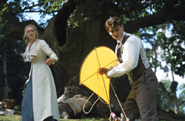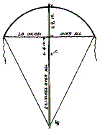Entries by Hifliercanada (97)
Kites in the Movie: Finding Neverland
Once in a while, kites are used in movies as a prop to help set the theme and the era of the film. Occasionally a kite actually becomes major prop. For example, the terrific Cody-type kite that was used to provide rapid propulsion assistance in Kevin Costner's WaterWorld. It was one of the most dramatic uses of a kite in a movie that I have ever seen.
Now there is a new movie about to be released (October 22, 2004) which will feature a kite that is historically correct for the period setting of the movie. In the new movie Finding Neverland, Director Marc Forster (Monster's Ball) uses a kite to help detail a setting between the principal actors Johnny Depp and Kate Winslet.
Finding Neverland is a tale of magic and fantasy inspired by the life of James Barrie, the real-life author of the children's classic Peter Pan. Set in London in 1904, the film follows Barrie's creative journey to bring Peter Pan to life, from his first inspiration for the story up until the play's premiere at the Duke of York Theatre - a night that will change not only Barrie's own life, but the lives of everyone close to him.
More information on Barrie, his life and the famous book that he wrote can be found in Petri Liukkonen's wonderful web site of biographies of famous authors.
The kite used in the brief pastoral scene in the movie is an English arch top kite. It appears that the sail is made of modern day nylon and not the more correct carefully stretched paper sail material of the era. From the photo it is difficult to ascertain the materials used in the framing of the kite.
 The English arch top kite is a modification of the very basic two-stick lite. It is usually made like the two-stick kite with an arched top formed by an additional curved framing strip of rattan or bamboo. A line drawing of the "English Arch Top Kite" shows its structure.
The English arch top kite is a modification of the very basic two-stick lite. It is usually made like the two-stick kite with an arched top formed by an additional curved framing strip of rattan or bamboo. A line drawing of the "English Arch Top Kite" shows its structure.
It appears that the kite in the movie foregoes the tassels on the cross spar but it does feature a tail for stability. In addition, the kite in the movie:
- does not seem to be of the same dimensional proportions as a typical arch top kite.
- the section of the kite above the cross spar appears to be taller and the more of a curve is used than in an original design.
- the length of the kite below the cross spar is somewhat shorter. However, the angle at which the kite is being held in the photo could account for the appearance of differences in dimension.
Although I want to see the movie because of the story of Barrie's life (it is fascinating), the added pleasures of two optical delights: a yellow arch top kite -and- Kate Winslet will also draw me to the box office!
Bell Tetrahedral Kites

 Bell's work with the Aerial Experiment Association led to the development of four different airplanes, or aerodromes, as Bell liked to call them. The most famous of these planes in Canada is "The Silver Dart". It was the first plane to fly in the British Commonwealth. On February 23, 1909, with John A.D. McCurdy at the controls, the aeronautical beauty lifted off from the ice of Bras'd'Or Lake, Baddeck, Nova Scotia. It was a milestone in aviation and the high point of the work conducted by Bell's Aerial Experiment Association.
Bell's work with the Aerial Experiment Association led to the development of four different airplanes, or aerodromes, as Bell liked to call them. The most famous of these planes in Canada is "The Silver Dart". It was the first plane to fly in the British Commonwealth. On February 23, 1909, with John A.D. McCurdy at the controls, the aeronautical beauty lifted off from the ice of Bras'd'Or Lake, Baddeck, Nova Scotia. It was a milestone in aviation and the high point of the work conducted by Bell's Aerial Experiment Association.Bell also did a lot of work during this period with tetrahedral kites and his massive Cygnet was a huge cellular contraption (3,393 tetra cells) that boggles the imagination.
 Although the Cygnet did achieve a short lift off from the surface of the lake, it did not release from it's tow rope upon landing back on the lake and was pulled into the water causing a huge amount of damage. The Cygnet was the largest tetrahedral kite ever constructed. It was disassembled following its initial brief flight and was never flown again. However, with this kite, Bell demonstrated that the tetrahedral form was very strong and could be aggregated to make large, durable obects.
Although the Cygnet did achieve a short lift off from the surface of the lake, it did not release from it's tow rope upon landing back on the lake and was pulled into the water causing a huge amount of damage. The Cygnet was the largest tetrahedral kite ever constructed. It was disassembled following its initial brief flight and was never flown again. However, with this kite, Bell demonstrated that the tetrahedral form was very strong and could be aggregated to make large, durable obects.




